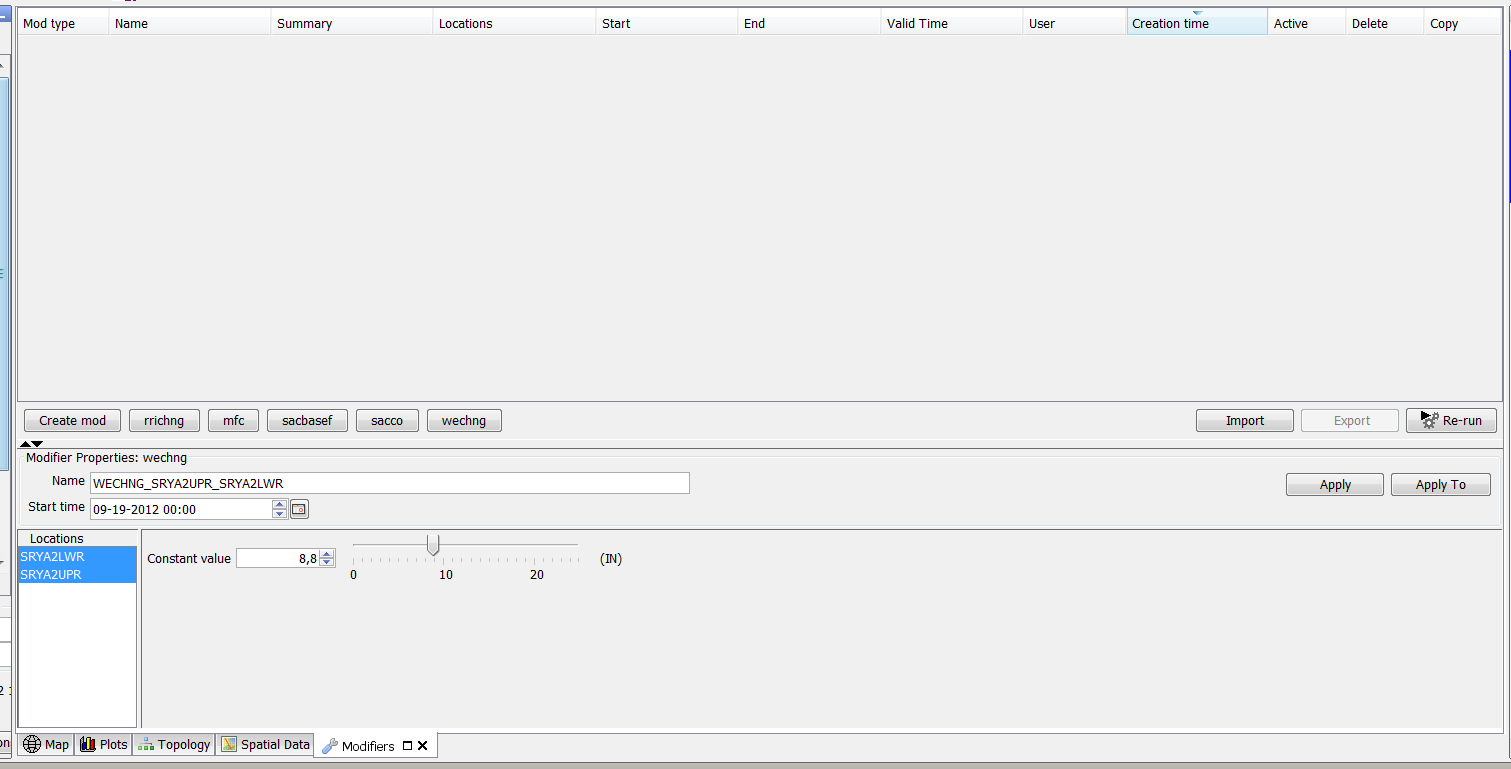...
- location attribute modifiers,
- module parameter modifiers,
- time series modifiers,
The modifiers.xml defines is used to define which modifiers are available within a fews configuration. The modifiers can be
created in the modifiers panel. TimeValue-modifiers can also be created in the plot display by graphically
editing a time series or by changing values in the table.
...
rollbackOverlappingModifiers
If an OC detects that another user committed new committed modifiers which overlap with local non-finalized modifiers then the changes made by these local modifiers will be deletedrolled back.
autoCommit
By default local modifiers are committed when the user starts a server run in which these modifiers are used. When this option is enabled the modifiers will be committed directly after the moment they are changed.
Location attribute modifiers
...
The display for the single value modifiers is shown below.
The user can enter a value in the text box by entering a value and by clicking on the spinner box next to it.
The value can also be adjusted by the slider bar.
The date of the modifier can be selected in the area above which the forecaster can enter a value for the modifier.
The units of the modifier is shown at the right side of the slider bar.
Configuration example
| Code Block | ||
|---|---|---|
| ||
<singleValueModifier id="wechng" name="wechng">
<timeSeries>
<parameterId>WECHNG</parameterId>
</timeSeries>
<softLimits>
<maximumValue>25</maximumValue>
<minimumValue>0</minimumValue>
</softLimits>
<hardLimits>
<maximumValue>100</maximumValue>
<minimumValue>0</minimumValue>
</hardLimits>
<defaultValue>5</defaultValue>
</singleValueModifier> |
schema
timeSeries
The tag timeseries is used to define to which timeseries this modifier can be applied.
...
When the principal component analysis is run in the plot display by selecting the principal component analysis-function the output value of this function will be default value for the modifier.
Configuration example
<singleValueModifier id="wechng" name="WECHNG"> <timeSeries> <parameterId>WECHNG</parameterId> </timeSeries> <softLimits> <maximumValue>5</maximumValue> <minimumValue>0</minimumValue> </softLimits> <hardLimits> <minimumValue>0</minimumValue> </hardLimits> <defaultTime>start run</defaultTime> <defaultValue>0</defaultValue> </singleValueModifier>
First the id and name of the modifier is declared. In this case this instance of the singeValueModifier will be identified by wechng.
The timeSeries-part identifies that this modifier can be applied to any time series which have the parameter WECHNG.
The modifier has soft limits configured. These limits are used to limit the slider bar in the display.
In this example the slider bar will start at 0 and end at 5. But these soft limits can be overruled by
manually typing a value lower than zero or higher than 5.
The hardLimits identify the upper and lower limit of the mod and they can not be overruled.
This means that for this mod only the maximum value of the soft limit of 5 can be overruled because there
is a minimum value configured in the hard limits of 0. A single value modifier is only applied at one time step.
By default the time step is set to the start of the run in this modifier. The default value is set to 0.
Constant value modifiers
Constant value modifiers are very similar to single value modifiers. But instead of modifying a single value at a
particular point in time, they modify a time series over a period of time with a fixed value.
...

